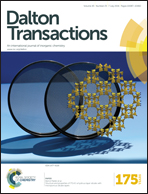Compact film fabrication of porous coordination polymer Co3[Co(CN)6]2 and its reversible vapochromic behavior†
Abstract
Films of Prussian blue analogue (PBA) Co3[Co(CN)6]2 were fabricated on porous α-alumina, ITO glass, silicon wafer and non-woven fabric substrates via a facile self-assembly method, and were characterized using infrared spectroscopy, X-ray powder diffraction and scanning electron microscope techniques. The films composed of truncated cube-shaped PBA particles are highly oriented with a preferred (100) plane on the glossy and smooth surfaces of ITO glass and silicon wafer, but crystallographically isotropic on the rough surface of porous α-alumina and non-woven fabric substrates. Compact films were achieved on porous α-alumina and surface-functionalized ITO glass. Reversible solvatochromism/vapochromism was discovered and investigated for the powdered and thin-film PBA samples. Such peculiar solvatochromism/vapochromism is related to the process of the adsorbed solvent molecules replacing the coordinated water molecules in octahedral Co2+–(N)4(H2O)2. The change of the Co2+ ion’s coordination atmosphere leads to the variation of crystal field strength, as a result, the d–d transitions within the Co2+ ions are altered to give rise to a color change.
![Graphical abstract: Compact film fabrication of porous coordination polymer Co3[Co(CN)6]2 and its reversible vapochromic behavior](/en/Image/Get?imageInfo.ImageType=GA&imageInfo.ImageIdentifier.ManuscriptID=C6DT01612J&imageInfo.ImageIdentifier.Year=2016)

 Please wait while we load your content...
Please wait while we load your content...